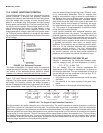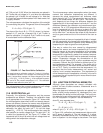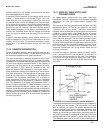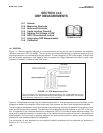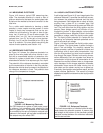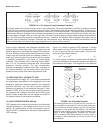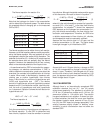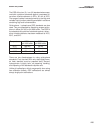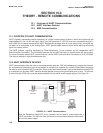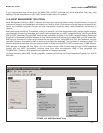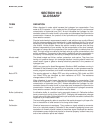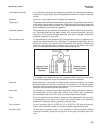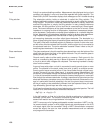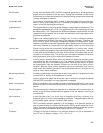
124
The Nernst equation for reaction 3 is:
E = E°- (4)
Note that the hydrogen ion factor in the concentration
ratio is raised to the fourteenth power. The table shows
the expected effect of changing pH on the measured
ORP at 25°C.
pH changes ORP changes by
from 2.0 to 2.2 7 mV
from 2.0 to 2.4 35 mV
from 2.0 to 1.8 47 mV
from 2.0 to 1.6 75 mV
The Nernst equation can be written for any half reaction.
However, not all half reactions behave exactly as predict-
ed by the Nernst equation. Why real systems do not act
as expected is beyond the scope of this discussion. The
potential of chromium (VI) - chromium (III) couple used as
an example above does not perfectly obey the Nernst
equation. However, the statement that pH has a strong
effect on the electrode potential of the couple is true.
• As mentioned earlier, ORP is best suited for measur-
ing changes, not absolute concentrations. If ORP is
used to determine concentration, great care should be
exercised. An example is the determination of chlorine
in water. When water is disinfected by treatment with
chlorine gas or sodium hypochlorite, free chlorine
forms. Free chlorine is a mixture of hypochlorous acid
(HOCl) and hypochlorite ions (OCl
-
). The relative
amount of hypochlorous acid and hypochlorite present
depends on pH. For disinfection control, total free chlo-
rine, the sum of hypochlorous acid and hypochlorite
ion, is important. Equation 5 shows the half reaction for
hypochlorous acid:
HOCl + H
+
+ 2e¯ = Cl¯ + H
2
O (5)
The Nernst equation is
E = E° - (6)
Only the concentration of hypochlorous acid appears in
the Nernst equation. To use ORP to determine total
free chlorine, equation 6 must be rewritten in terms of
free chlorine. Although the details are beyond the scope
of this discussion, the result is shown in equation 7:
E = E° - (7)
where K is the acid dissociation constant for hypochlor-
ous acid (2.3 x 10
-8
) and C
a
is the total free chlorine
concentration. As equation 7 shows the measured
ORP depends on the hydrogen ion concentration (i.e.,
pH), the chloride concentration, the free chlorine con-
centration, and temperature. Therefore, for ORP to be
a reliable measurement of free chlorine, pH, chloride,
and temperature must be reasonably constant.
Assume the free chlorine level is 1.00 ppm and the
chloride concentration is 100 ppm. The table shows
how slight changes in pH influence the ORP.
pH changes ORP changes by
from 8.0 to 7.8 3.9 mV
from 8.0 to 7.6 7.1 mV
from 8.0 to 8.2 4.4 mV
from 8.0 to 8.4 9.2 mV
Around pH 8 and 1.00 ppm chlorine, a change in ORP
of 1.4 mV corresponds to a change in chlorine level of
about 0.1 ppm. Therefore, if pH changed only 0.2 units
and the true chlorine level remained constant at 1.00
ppm, the apparent chlorine level (determined by ORP)
would change about 0.3 ppm.
14.8 CALIBRATION
Although there is no internationally recognized ORP
calibration standard, the iron (II) - iron (III) couple
enjoys some popularity. The standard is a solution of
0.1 M iron (II) ammonium sulfate and 0.1 M iron (III)
ammonium sulfate in 1 M sulfuric acid. The solution
has good resistance to air oxidation. If stored in a tight-
ly closed container, the shelf life is one year. Because
the standard contains equal amounts of iron (II) and
iron (III), the ORP does not change appreciably if the
solution becomes slightly diluted. In addition, minor
variability in actual concentration does not affect the
standard ORP.
MODEL 3081 pH/ORP SECTION 14.0
ORP MEASUREMENTS
0.1987 (t + 273.15)
log
[Cr
+3
]
2
6 [Cr
2
O
7
-2
] [H
+
]
14
0.1987 (t + 273.15)
log
[Cl
-
]
2 [HOCl] [H
+
]
0.1987 (t + 273.15)
log
[Cl
-
] {[H
+
] + K}
2 C
a
[H
+
]
2



